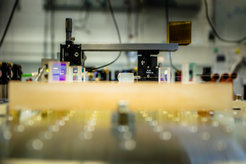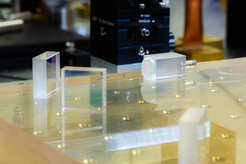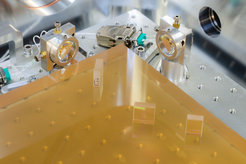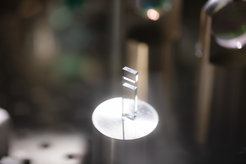GT4ET
Glass Technologies for the Einstein Telescope
Researchers at the Max Planck Institute for Gravitational Physics in Hannover are working with colleagues at the Fraunhofer Institute for Applied Optics and Precision Engineering (Fraunhofer IOF) to develop miniaturised opto-mechanics for the Einstein Telescope, the planned third-generation gravitational-wave detector in Europe.
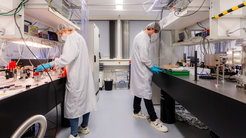
Scientists are currently preparing new and even more sensitive gravitational-wave observatories on Earth that will eavesdrop on the cosmos from the 2030s on. These so-called “third-generation” detectors will cover a frequency range similar to that of the current instruments, but with up to 10 times the sensitivity. The European project is called the “Einstein Telescope”. AEI Hannover has long been a leading institution in gravitational wave research, is a co-initiator of the Einstein Telescope and involved in several areas in the preparation and development of the Einstein Telescope.
To enable observations with significantly increased sensitivity, further technical improvements are required in addition to larger detector facilities. In the project “Glass Technologies for the Einstein Telelscope” (GT4ET) of the Max Planck Institute for Gravitational Physics (Albert Einstein Institute, AEI) in Hannover and the Fraunhofer Institute for Applied Optics and Precision Engineering (Fraunhofer IOF), new technologies for seismic isolation and laser stabilisation are being developed for the Einstein Telescope.
Developing sensors for improved seismic isolation
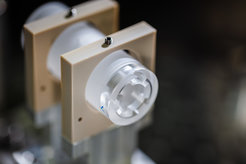
The main optics of the laser interferometric detectors, i.e., their mirrors and beam splitters, will be isolated as far as possible from any environmental ground motion (seismic noise) via complex mechanical filters. The optical elements are suspended from multi-stage pendulums for this purpose. These multiple pendulums attenuate the seismic noise and are also used in current gravitational-wave detectors.
To enable active damping, the positions of the individual masses within the pendulum suspension must be precisely determined relative to a reference point. Currently, there are no suitable compact sensors for this measurement. In GT4ET, researchers from AEI and IOF will therefore develop a measuring head that generates diffractive optics via metasurfaces and will be firmly connected to an optical measuring device via optical joining techniques.
Laser stabilisation with micro-oscillators
The properties of the lasers used in the gravitational-wave detectors are actively stabilized to minimize their noise in frequency, power and beam geometry. AEI has accumulated experience over many years in the design, stabilization, fabrication, and installation of lasers in gravitational-wave interferometry on Earth.
A new method of stabilizing the power of lasers for gravitational-wave detectors that is currently being explored and has already yielded good initial results is stabilization using a micro-oscillator. The AEI and the IOF are developing this technology further within the framework of GT4ET and are realizing a concrete concept for it.
Publications
From our labs
